At first sight, the discovery call might not seem all that important. I know salespeople who go as far as to consider it nothing but a warm-up chat to “suss out” the prospect.
In truth, however, you will never have a more important conversation with a prospect than a discovery call.
This is when the two of you connect, after all. This is your opportunity to make a great first impression AND to learn what makes the prospect tick.
I’d even go as far as to say that everything else you do during the sales process stems from the information you’ve learned during the discovery call.
In other words, a sales discovery call is a pretty big deal.
Here’s all the information you need to have to conduct it successfully.
Let’s first define the discovery call in sales.
The “official” definition of a sales discovery call explains it as the very first conversation you have (or you should have – more on this shortly) with a prospect after they’ve shown an interest in your product or service.
I like to explain the concept of the discovery call differently, using a simple example.
Imagine that you sell the services of a business consulting company helping other enterprises improve processes and streamline production. You receive an inquiry from a potential customer. They’ve filled in your lead form diligently, answered all the questions you’ve asked there, and provided you with a quick overview of their problem. It could look like this.
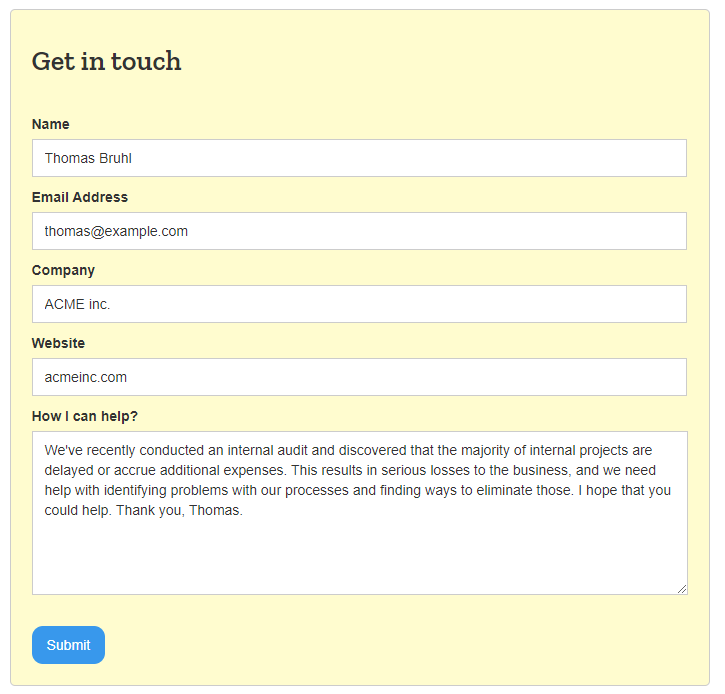
(An example of a typical inquiry through a lead capture form.)
Based on this inquiry, you have two options:
- One is to start the sales process. For example, you could reply to their inquiry and send them an overview of your services, typical rates, timelines, and other information the person would need to know to hire you. The prospect can review that and decide whether they want to engage with your company or not.
- The other is to sit down with the prospect for 15 minutes, and ask additional questions to find out more about their problem, the current situation, etc.
Now, to be clear – Both options can get you the sale. But it’s the other one that can generate the most success for your company, and that other option is the discovery call.
Here’s why:
- The discovery call allows you to uncover more information than you could ever ask for in a lead capture form, for example.
- This short meeting (note – we’ll talk more about the ideal length for the call shortly) can provide you with enough information to determine whether the prospect is a good fit for your business. And given that as many as 50% of prospects might not be a good fit for what you’re selling, the discovery call helps you avoid acquiring the wrong customers.
- Similarly, the call allows the prospect to understand your products or services better and decide whether this is something for them.
- During the call, you and the prospect can discuss which of your company’s solutions suit them best too.
- The discovery call also gives you the opportunity to make a good first impression. By asking the right questions, you can present yourself and your organization as experts in the field and build trust.
- Finally, as you’ll shortly see, the discovery call is also when you set up the next actions and push the sale further.
When should you have the discovery call with a prospect?
The discovery call should be your first in-person interaction with them. I recommend that you suggest scheduling the call or meeting in your first reply to the person’s inquiry. As the name suggests, the call is your chance to discover more about the prospect and decide whether they’re a good fit. So, the earlier in the process you have that conversation, the better.
How long should the sales discovery call be?
I admit that this is a bit of a tricky question. The most logical answer is that it should last as long as it takes for you to get all the necessary information from the prospect.
In reality, though, this isn’t that easy:
- The call serves as a way for you to evaluate whether the prospect is a fit and whether it makes sense to invest more time and effort into them. As a result, you shouldn’t be putting too much time into this.
- The length of the call will also depend on the services you sell. If you sell complex services, then you might need to spend more time discussing how your solutions can help the prospect. You may not need as much time if you offer simpler services that the prospect is familiar with.
- Some experts suggest also matching the initial investment with the projected customer lifetime value (LTV). And so, if the LTV is low (say, below $2000), the call should be shorter. You could invest more time initially into higher-value deals. Personally, I don’t subscribe to this idea but I thought I’d include it here.
Then there’s the data.
According to this research, for example, top sales performers conduct 76% longer discovery calls than other salespeople. According to the data, top performers’ sales discovery calls last 33 minutes, on average, while the rest of salespeople keep them at around 20 minutes.
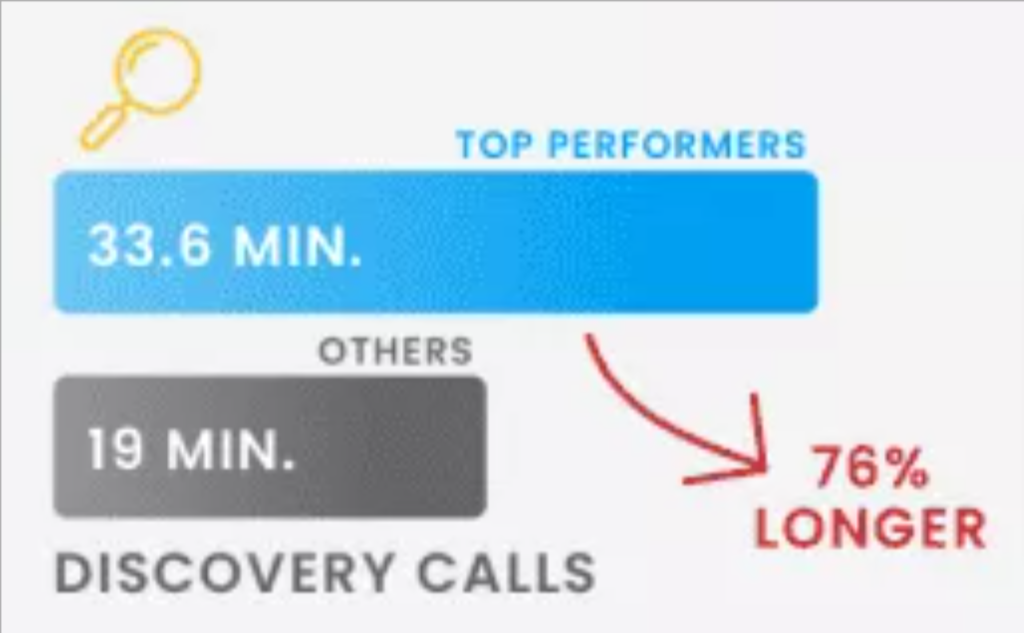
On average, I’d say that you should keep your discovery calls no shorter than 15 minutes and no longer than an hour. Anything longer than that is really a sales presentation, and that’s a completely different type of engagement.
How to plan the sales discovery call
By now, you know how serious the discovery call is for sales. That short meeting with the prospect can change everything about the sale. Because of that, it’s not something that you should ever leave to chance.
Let me use the same study I referenced earlier to signify this.
According to the research, on average, top sales performers ask 32 questions during the discovery call.
Thirty-two! Imagine that…
What’s more, that’s 39% more questions that other salespeople prepare for their discovery calls.
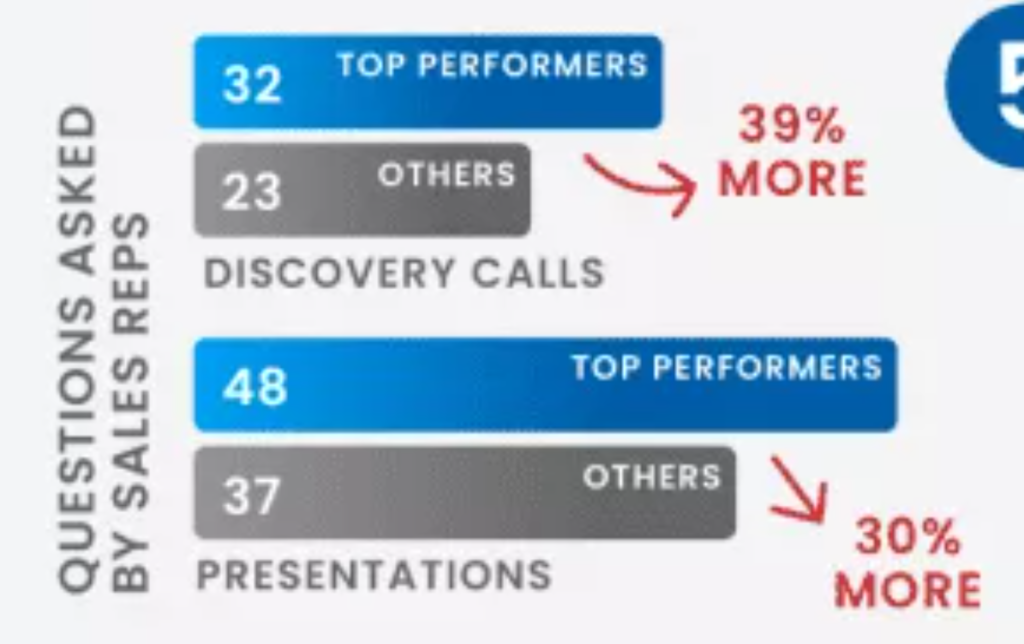
And let’s face it; you can’t get to that level without meticulously preparing those questions and having a plan on how to conduct the discovery call.
So, let’s discuss how you could do the same.
I recommend that you prepare for every discovery call using this 5-step plan:
- Research the prospect
- Plan the agenda
- Prepare your questions
- Build rapport
- Set next actions
Let’s go through each of those in turn.
A quick note before we begin – Based on these five points, it may seem that you need to conduct this research individually for every discovery call. No, that’s not true. Of course, you need to research each prospect individually. That’s a given. But you can create a process and templates for it, which will help you streamline the research.
Researching the prospect
As with many other aspects of selling – prospecting, cold outreach, etc. – the first thing to do is to learn as much as possible about your prospect.
Depending on how they’ve inquired with you, you might have some basic information about them. You certainly have their name and email address. You might be collecting additional information in the lead capture form and as a result, know their position in the company, their market, and so on.
This legal marketing agency, for example, asks leads to specify their firm’s primary practice area. This single field helps them decide whether the prospect is a fit or not.
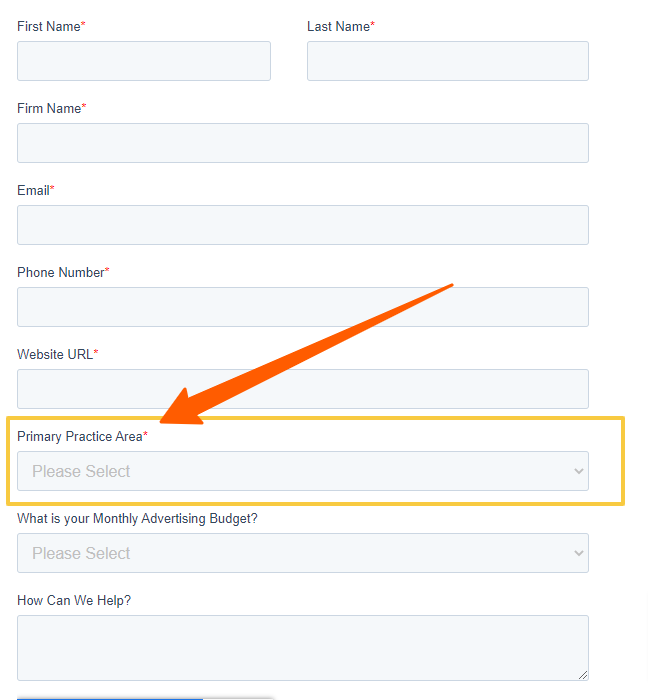
But even the basic contact information is enough for you to conduct extensive research on the prospect.
And, as I said above, you can create a simple process for doing so:
- Visit their website. See if the company operates in markets that your product or service is for.
- Research the company. This could be as simple as visiting its About page or checking its LinkedIn profile. The goal here is to learn things like the company size, how they’ve been in business, their structure, etc. Again, this information might help you decide whether they match your ideal customer profile.
- Visit the prospect’s LinkedIn profile too. See if they’re the decision maker or whether you should be requesting another person to attend the discovery call too.
- Research your lead on Google or social media. This might help you identify things you have in common with them and help you build rapport during the discovery call.
The goal of this research is to collect as much information that would help you evaluate the business as a potential fit and conduct the discovery call successfully.
Planning the agenda
I realize that it will sound lame, but it’s also true – You should never leave anything to chance in sales.
This also applies to how you conduct discovery calls.
Now, to be clear, I don’t say that your call should have a rigid format. It’s not a presentation, after all. It’s fine to let prospects guide parts of it. The call is also their opportunity to explain the problem and discuss the solution.
But you should have at least a rough idea of what you want to cover during the call.
Also, having an agenda (and sticking to it,) will put you in control and communicate your expertise and authority to the prospect.
I recommend that, at minimum, you include the following items in your discover call’s agenda:
- Your introduction. This doesn’t have to be a long section but open the meeting with quick information about yourself, your role in the company, and your professional background.
- Rapport. We’ll cover this in more detail shortly. But overall, remember to plan for at least a short casual chat to break the ice and connect with your prospect.
- Discovery call objectives. To keep control over the meeting, set a section to discuss what you plan to discuss and achieve during the call. It can be as simple as stating something like: “Our plan for this call is to get to know your company and learn more about your problem/goals. At the end of this call, we both should have a good idea about whether we’re a fit and how my company could help yours overcome your problem.”
- Questions. This is when you’ll be asking all the questions you’ve prepared for the prospect.
- Next steps, providing you both agree that you’re a fit.
Preparing your questions
I know that most salespeople find it difficult to envision what to ask prospects. Yet, the harsh truth is that without having those questions at hand, your discovery call simply won’t work.
There are several reasons why:
- Questions allow you to uncover the exact information you need to qualify the prospect.
- They also help you control the conversation and prevent prospects from going off-topic.
- Not to mention that your questions will get them to talk in the first place. Not all prospects are talkative. Sometimes they need to hear questions to be able to start talking about their situation.
Using the study I referenced earlier, top sales performers get prospects to talk way more than other salespeople. Let’s face it; the only way they can do this is by having relevant questions at hand.
Now, it’s virtually impossible for me to offer any templates for your discovery call questions. These will largely depend on the type of business you’re in, your products or services, the target market, and hundreds of other factors.
But I can offer you some pointers as to what to ask about:
- Focus on pain points. Your goal is to figure out whether you can solve the prospect’s problem after all. So, focus on asking questions that dig deeper into their challenges and help you uncover underlying reasons for those.
- Ask about their goals, also those relating to the potential engagement with your business. You can also dig deeper here. For example, not only ask what their goals are but get the prospect to talk about what’s at stake if they don’t reach those.
- Try getting the full picture. This may also require you to ask about other solutions the prospect has tried before reaching out to you – And that could mean things they tried to do internally and what other companies they’ve been working with.
- Don’t be afraid to ask about their current situation – The budget, projected timelines, etc.
- Include questions about their buying process – From who’s the decision maker to any steps they’d require you to complete should you two decide to work together.
TIP – Avoid close-ended questions. Don’t ask for anything that the prospect could just respond with a simple yes or no. At first, these questions seem ideal as they help you confirm your hypotheses. In reality, though, they prevent a conversation from developing. Sure, you get the information you need this way. But you will struggle to dig deeper and uncover the reasons for the prospect’s answers. So, always phrase the question so that the prospect needs to provide more information to answer it.
Plan for building rapport
The discovery call is not only your opportunity to qualify a prospect. It’s also a chance for the two of you to connect. According to research by Walker, for example, prospects are more likely to trust salespeople they find relatable.
And in this blog post, Jeffrey Gitomer writes:
“If you find common subjects or interests with a prospect, you can establish a business friendship, and people are more likely to buy from a friend than a salesperson.”
If you remember, we already talked about researching the prospect on Google, social media, LinkedIn, etc. This research was aimed at one thing only – To discover if you have something in common with them.
This doesn’t have to be anything major. You don’t have to know the same people (although it always helps if you do.) But maybe you come from the same area? Or maybe the prospect follows the same sports team as you?
Anything could help you build that rapport. But beware here, whatever you decide to use, it has to be real. Prospects will quickly discover if you’re pretending to be following their favorite team, and you’ll never rebuild their trust if they do.
Planning the next steps
By far and away, this can easily be the most intimidating aspect of the discovery call. If you think about it, asking questions about the prospect’s situation is relatively easy. Inquiring about their feelings after the call and planning the next steps is something completely different.
It’s actually quite hard.
That’s why you should always have a plan for how to end the call.
A couple of years ago, I attended a talk by Steli Efti at SaaStock. During his talk, Steli mentioned one amazing way to end a discovery call (or any sales call at that.) I don’t remember the exact words he said, obviously, but his idea was to ask not for one next step but a whole set of them.
So, instead of just deciding on the next action after the discovery call (i.e., you send the prospect a proposal,) you inquire about what happens after that too. And then, what happens after that step is completed, and what happens after that, etc.
- For example, if, at the end of the call, you and the prospect decide that you’re a fit, you ask about the next step in their process.
- They reply that they need more information from you so that they can talk to their boss about it.
- Instead of leaving it at that, you inquire about what happens after you’ve sent that information.
- So, the prospect tells you that the boss will need to review it, and the person you’re meeting will send you an email with confirmation.
- Ask when that’s going to happen.
- If they say, two weeks, ask if it’s OK if you follow up around then.
- The prospect will, most likely, say yes. So, you can ask about what happens then.
- They might tell you about the contract you need to sign, etc.
- And again, you can ask when that’s going to be ready if it’s OK if you follow up, and what happens next.
You can use this method to outline all steps in the process until the very end, the actual deal happening.
The beauty of this approach is that not only it allows you to understand the prospect’s sales process better, but it also sets up the agenda for the whole deal to happen!
Should you follow up after the discovery call?
Yes, absolutely!
If you’ve used Steli Efit’s method I outlined above; you will have a clear plan of when to follow up and with what information.
But even if you’ve just set the next action, you can still follow up to get the prospect to follow through.
In fact, you could set a simple follow-up cadence using tools like Postaga (disclaimer, this is my product) to automate the process.
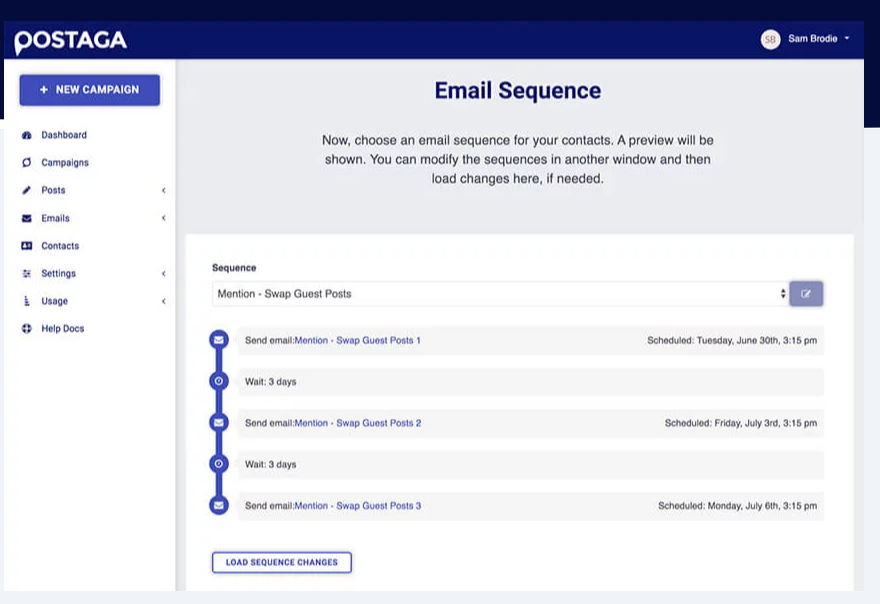
(An example of email sequence in Postaga)
Postage is a full-scope cold email outreach platform that lets you find relevant sales opportunities and introduce them to your business.
With Postaga, you can:
- Find people relevant and interested in your business, connect with them, and nurture those relationships.
- Validate their emails and contact information.
- Build and send personalized outreach emails quickly and easily.
- Keep track of your leads in the Postaga CRM.
Looking for a way to scale your outreach and email follow-up? Sign up for a free 14-day trial and see how Postaga can help.
Free 14-Day Trial
Start building relationships now with your fully-featured 14-day trial!
How We Compare
Terms | Done-For-You Terms | Privacy | Write For Us | Press
© 2025 Postaga. All Rights Reserved. Made with 
